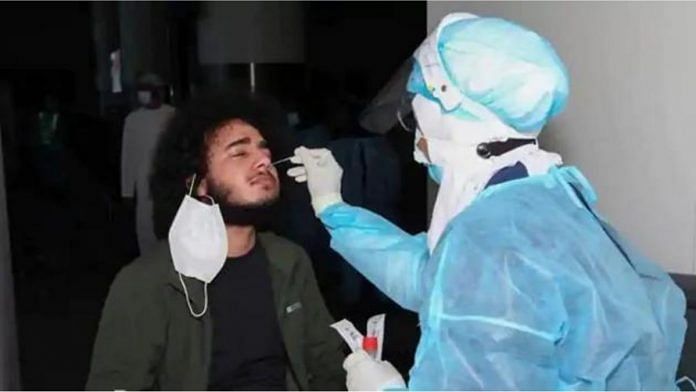New Delhi: The emergence of Omicron — a SARS-CoV-2 variant with at least 32 mutations in the spike protein — has health authorities across the world on alert. Interestingly, however, scientists have pointed out that the same mutations may actually make monitoring the variant easier.
Spike protein is the protruding part of the coronavirus that allows the pathogen to enter the host cell.
According to researchers, some of the RT-PCR tests used to detect whether or not a person is Covid positive can also be useful screening tools to detect people who are likely carrying the Omicron variant.
Vinod Scaria, a leading researcher in the field of genomics at the Council of Scientific and Industrial Research’s (CSIR’s) Institute Of Genomics And Integrative Biology (IGIB) explained to ThePrint the science behind how the mutations may make it easier to detect Omicron.
Also read: Omicron variant could have emerged from AIDS patient with prolonged Covid, scientists suspect
Identifying the virus
To test SARS-CoV-2, researchers have to pick out specific areas in the genetic code that don’t rapidly change during the course of the virus’s evolution, but are properties that allow it to be recognised.
These are repeatedly copied and amplified in a process called the polymerase chain reaction, or PCR, which forms the basis of the coronavirus test and lends its name to it.
Primers, which are small pieces of DNA designed only to bind to specific DNA sequences, are used to bind to SARS-CoV-2’s viral genome and thus detect the presence of Covid-19 in a person’s samples. The primers along with a fluorescent dye — which is known as a probe — are put in a small reaction tube and then into a PCR machine where the “binding” process takes place.
Scaria explained that typically there are two or more sets of primers in the Covid-19 RT-PCR test kits which bind with the genetic material of the virus at two or more sites in the RNA sequence.
This is done to improve the detection and it reduces the chances of false positives.
Usually, genes from two of the several proteins of the virus, such as the spike, envelope, receptor-binding domain and nucleocapsid proteins are used.
Sometimes, mutations in these proteins can affect the efficiency of the testing kit. But since two sites are used, it is rare that both sites are lost due to mutations, Scaria said, although it is possible in rare instances.
A number of variants — including Alpha and Omicron — have mutations in the gene of the spike protein, which can adversely impact the efficiency of the primers widely used.
“This is called a spike-drop out on a Spike Gene Target Failure (SGTF). This is usually not an issue, since the second primer works,” Scaria wrote in a Twitter thread.
SARS-CoV-2 Variants and RT-PCR
Can RT-PCR Detect Omicron ?
A short thread on the topic. ? pic.twitter.com/dZMNWCgeY6
— Vinod Scaria (@vinodscaria) November 29, 2021
“This property can therefore be used as a surrogate to screen for specific variants,” he added.
Also read: Vaccine inequity can lead to more Covid variants, waive IP rights immediately, India warns WTO
Primer for Omicron
While the Omicron variant will not bind to the primer that targets the spike protein, other primers in the test will still bind to their target. Whether a kit can detect a variant is therefore dependent on the primers used.
However, such mutations can occur in other variants, so an RT-PCR test can only serve as a quick screening tool. The variant will then have to be confirmed using genome sequencing.
The current protocol to screen for Covid variants, as laid out by the health ministry, requires samples of travellers who test positive for Covid to be sent for genome sequencing.
However, India’s genome sequencing capacity is limited — with just about 96,312 samples sequenced through the course of the pandemic as on 8 November.
Moreover, it can take up to two days to sequence a sample — during which time the infection may end spreading to more people.
(Edited for Poulomi Banerjee)
Also read: Why Covid cases in India are decreasing, despite low double vaccination rate



